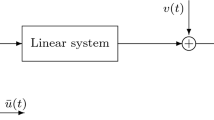Abstract
A P-set (P \(=\) packet) is a new set model with dynamic characteristics, which is a set pair of finite common elements composed of internal P-Set \(X^{\overline{F}}\) and outer P-Set \(X^{F}\), in other words, \((X^{\overline{F}}, X^{F})\) is a P-Set. P-augmented matrix is a new concept and structure of augmented matrix by using P-Set to improve ordinary augmented matrix. In this paper, P-set and p-augmented matrix are used to present theorems and applications on matrix reasoning and reasoning theorem.
Similar content being viewed by others
Explore related subjects
Discover the latest articles, news and stories from top researchers in related subjects.Data Availability
Enquiries about data availability should be directed to the authors.
References
Fan C, Lin H (2012) P-sets and the reasoning-identification of disaster information. Int Converg Inf Technol 7:337–345
Lin H, Fan C (2012) The dual form of P-reasoning and identification of unknown attribute. Int J Digit Content Technol Appl 6:121–131
Ren X, Zhang L, Shi K et al (2018) Inverse P-augmented matrix method-based the dynamic findings of unknown information. Microsyst Technol 24:4187–4192
Shi K (2008) P-sets. J Shandong Univer: Nat Sci 43:77–84 (in Chinese)
Shi K (2009) P-sets and its applications. Adv Syst Sci Appl 9:209–219
Shi K (2012) P-sets, inverse P-sets and the intelligent fusion-filter identification of information. Comput Sci 39:1–13 (in Chinese)
Shi K (2015) P-augmented matrix and dynamic intelligent discovery-identification of information. J Shandong Univer: Nat Sci 50:1–12 (in Chinese)
Wang Y, Geng H, Shi K (2011) P-sets and dependence-discovery of dynamic information. Syst Eng Electron 33:2035–2038 (in Chinese)
Zhao S, Fan C, Shi K (2012) Outer P-information generation and its reasoning-sear-Ching discovery. J Shandong Univer: Nat Sci 47:99–104 (in Chinese)
Zhao S, Songli W, Shi K (2013) Internal P-reasoning information recovery and attribute hiding searching discovery. Comput Sci 40:209–213 (in Chinese)
Acknowledgements
The authors thank the Cultivation Programme for Young Backbone Teachers in Henan University of Technology, the Program of Department of Education of Henan Province (YJS2022JC16), the Fund of Henan Province (182102410049) and the NSFC (11926330).
Funding
The authors have not disclosed any funding.
Author information
Authors and Affiliations
Corresponding author
Ethics declarations
Conflict of interest
The authors declare that they have no conflict of interest.
Additional information
Publisher's Note
Springer Nature remains neutral with regard to jurisdictional claims in published maps and institutional affiliations.
Rights and permissions
About this article
Cite this article
Chen, X., Zhao, S. & Shi, K. Matrix reasoning and intelligent acquisition-application of unknown information. Soft Comput 26, 4607–4612 (2022). https://doi.org/10.1007/s00500-022-06947-7
Accepted:
Published:
Issue Date:
DOI: https://doi.org/10.1007/s00500-022-06947-7




